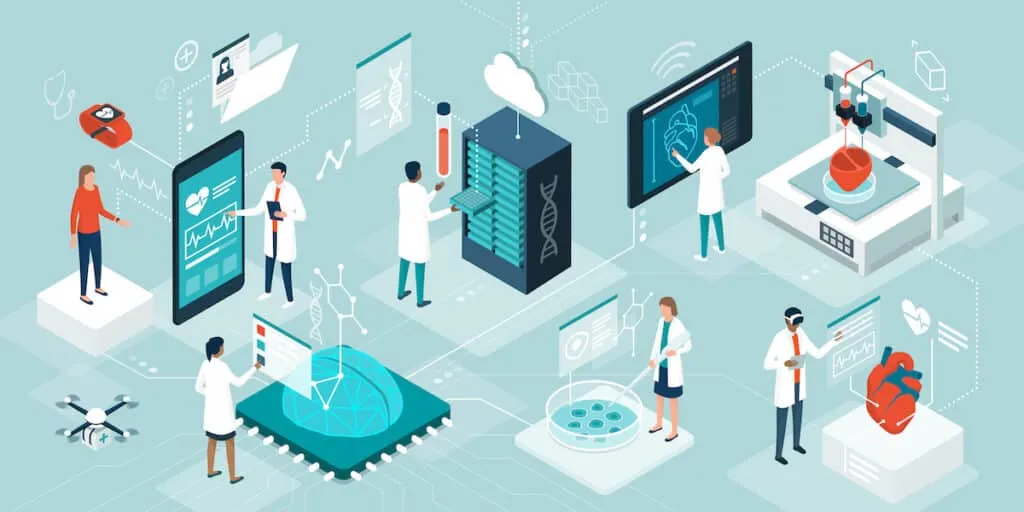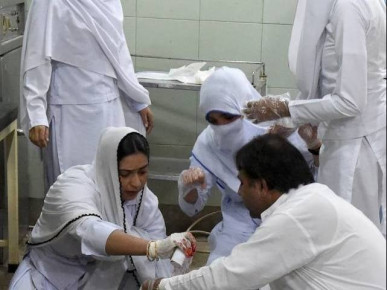Introduction
The healthcare industry is undergoing a radical transformation, driven by cutting-edge innovations that enhance patient care, streamline operations, and improve overall health outcomes. As we step into 2025, emerging healthcare technologies are reshaping diagnostics, treatment methodologies, and patient engagement, making medical care more accessible and efficient. From artificial intelligence to telemedicine, these advancements are not just futuristic concepts but tangible solutions revolutionizing the industry.

In this article, we explore the top 10 emerging healthcare technologies that are set to redefine patient care in 2025, their impact on the medical field, and how they will shape the future of healthcare.
Key Technologies Transforming Healthcare in 2025
1. Artificial Intelligence (AI) in Healthcare
AI is revolutionizing patient care by enabling faster diagnostics, personalized treatment plans, and enhanced medical research. AI-powered algorithms can analyze medical images, detect anomalies, and predict disease progression with unprecedented accuracy. Machine learning models are assisting in drug discovery, optimizing hospital workflows, and even providing AI-driven chatbots for patient consultations.
Key Benefits:
- Faster and more accurate diagnostics
- Personalized treatment recommendations
- AI-driven virtual health assistants
2. Telemedicine and Remote Patient Monitoring
The rise of telehealth solutions has made medical care more accessible than ever. With advanced telemedicine platforms, patients can consult doctors remotely, reducing hospital visits and saving time. Wearable devices and IoT-enabled sensors continuously monitor patient vitals, alerting healthcare providers in real-time about any anomalies.
Key Benefits:
- Increased access to healthcare in remote areas
- Continuous monitoring of chronic conditions
- Reduced burden on hospitals and clinics
3. 3D Printing in Medicine
3D printing technology is transforming healthcare by enabling the creation of customized prosthetics, implants, and even organ tissues. This innovation allows for more precise surgical planning, faster production of medical devices, and cost-effective solutions for patients requiring personalized care.
Key Benefits:
- Custom-made prosthetics and implants
- Bioprinting for organ regeneration
- Cost reduction in medical equipment production
4. Robotics in Surgery
Robotic-assisted surgeries are becoming increasingly common, offering greater precision, minimal invasiveness, and faster recovery times. Surgical robots, controlled by skilled surgeons, perform complex procedures with high accuracy, reducing the risks associated with traditional surgery.
Key Benefits:
- Enhanced surgical precision
- Reduced recovery time and post-operative complications
- Minimally invasive procedures
5. Blockchain for Healthcare Data Security
With the increasing digitization of medical records, blockchain technology is ensuring data security, integrity, and patient privacy. By decentralizing patient data, blockchain minimizes cyber threats, facilitates secure sharing of health records, and improves interoperability between healthcare providers.
Key Benefits:
- Enhanced data security and privacy
- Tamper-proof medical records
- Improved transparency and interoperability
6. Wearable Health Technology
Smartwatches, fitness trackers, and biosensors are becoming essential tools for real-time health monitoring. These devices track heart rate, blood oxygen levels, glucose levels, and more, empowering patients to take charge of their health and allowing doctors to receive timely data for better diagnosis and treatment.
Key Benefits:
- Continuous health monitoring
- Early detection of health issues
- Improved patient engagement
7. Nanomedicine
Nanotechnology is pushing the boundaries of medical treatment by enabling targeted drug delivery, early cancer detection, and regenerative medicine. Nanoparticles can deliver medications directly to affected cells, reducing side effects and increasing treatment efficiency.
Key Benefits:
- Precise drug delivery with minimal side effects
- Enhanced cancer treatment and detection
- Regenerative medicine applications
8. CRISPR and Gene Editing
CRISPR technology is revolutionizing genetics by enabling precise gene editing to treat hereditary diseases. By modifying faulty genes, scientists are exploring cures for genetic disorders such as sickle cell anemia, cystic fibrosis, and even certain cancers.
Key Benefits:
- Potential cures for genetic diseases
- Personalized medicine based on genetic profiles
- Advancements in regenerative medicine
9. Internet of Medical Things (IoMT)
The IoMT connects medical devices, sensors, and software to improve patient outcomes and hospital efficiency. Smart medical devices communicate data in real-time, allowing healthcare professionals to make informed decisions and automate critical processes.
Key Benefits:
- Improved patient monitoring and data collection
- Reduced hospital readmissions
- Enhanced efficiency in healthcare operations
10. Augmented Reality (AR) and Virtual Reality (VR) in Healthcare
AR and VR technologies are transforming medical training, pain management, and patient education. Surgeons can use AR for pre-operative planning, while VR is being employed in pain management therapies and mental health treatments.
Key Benefits:
- Enhanced surgical training and simulation
- Effective pain and anxiety management
- Improved patient education and engagement
Conclusion
As we move into 2025, these emerging healthcare technologies are set to redefine patient care, making medical treatment more efficient, accessible, and personalized. From AI-driven diagnostics to blockchain-secured data and wearable health monitors, the future of healthcare is being shaped by innovation. Embracing these advancements will not only improve health outcomes but also revolutionize the way healthcare providers operate, ensuring a more effective and connected medical ecosystem.
FAQs
Q1: How is AI transforming patient care in 2025?
AI is revolutionizing patient care by enabling early disease detection, personalized treatment plans, and automated workflows in hospitals, leading to improved efficiency and accuracy in healthcare.
Q2: Are wearable health devices reliable for medical monitoring?
Yes, wearable health devices have advanced significantly, providing accurate real-time health data that assists doctors in monitoring patients remotely and detecting early warning signs of illnesses.
Q3: What are the biggest benefits of telemedicine?
Telemedicine increases healthcare accessibility, reduces hospital congestion, and allows continuous monitoring of chronic patients, making healthcare more efficient and convenient.
Q4: How does blockchain improve healthcare data security?
Blockchain ensures secure, tamper-proof medical records, enhances patient privacy, and improves interoperability between healthcare providers by decentralizing patient data.
Q5: Will 3D printing replace traditional medical equipment manufacturing?
While 3D printing won’t fully replace traditional manufacturing, it offers cost-effective, customized solutions for prosthetics, implants, and surgical tools, improving accessibility to medical devices.
With these innovations, 2025 is set to be a groundbreaking year for healthcare, enhancing patient care through cutting-edge technologies and smart medical solutions.







